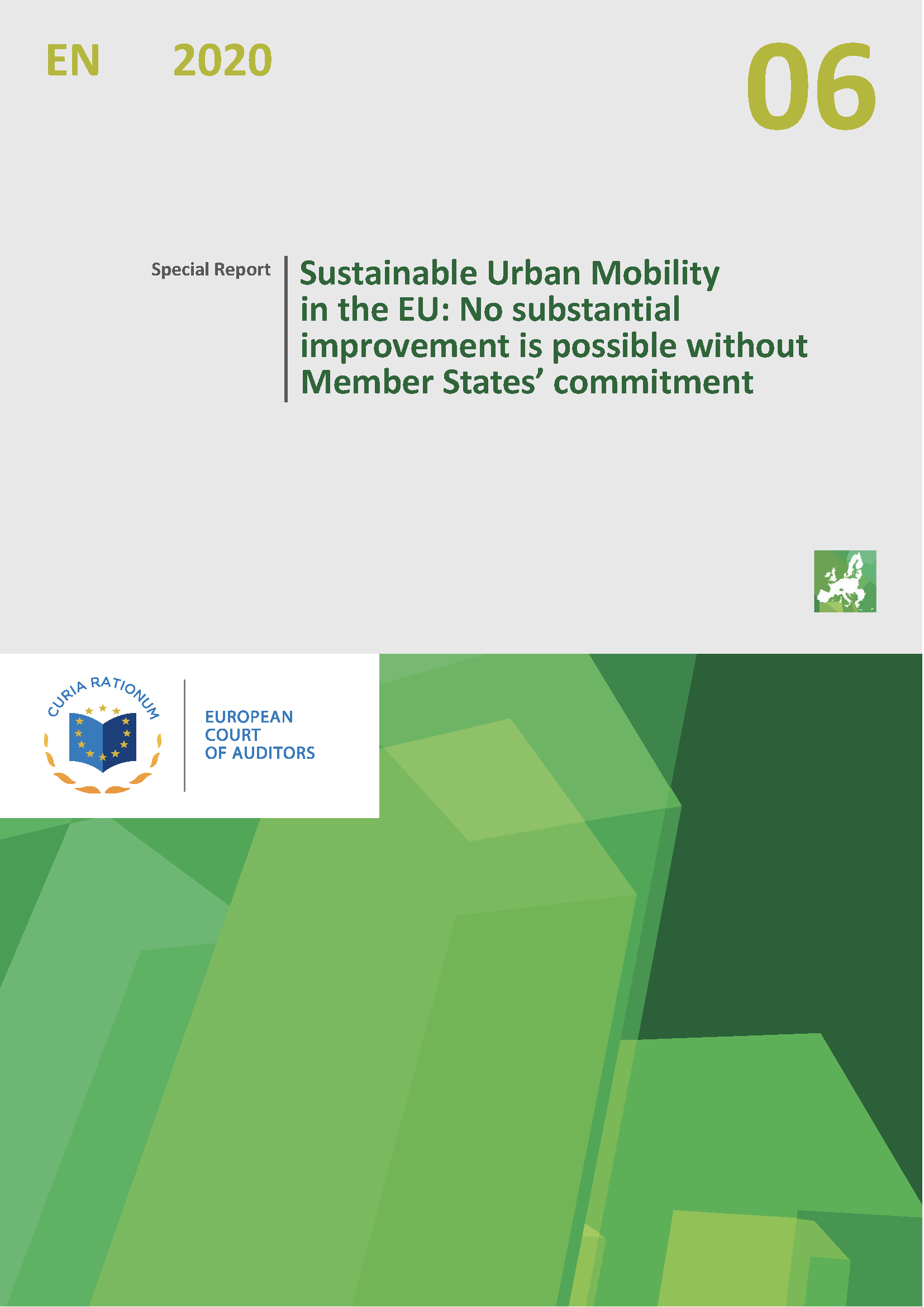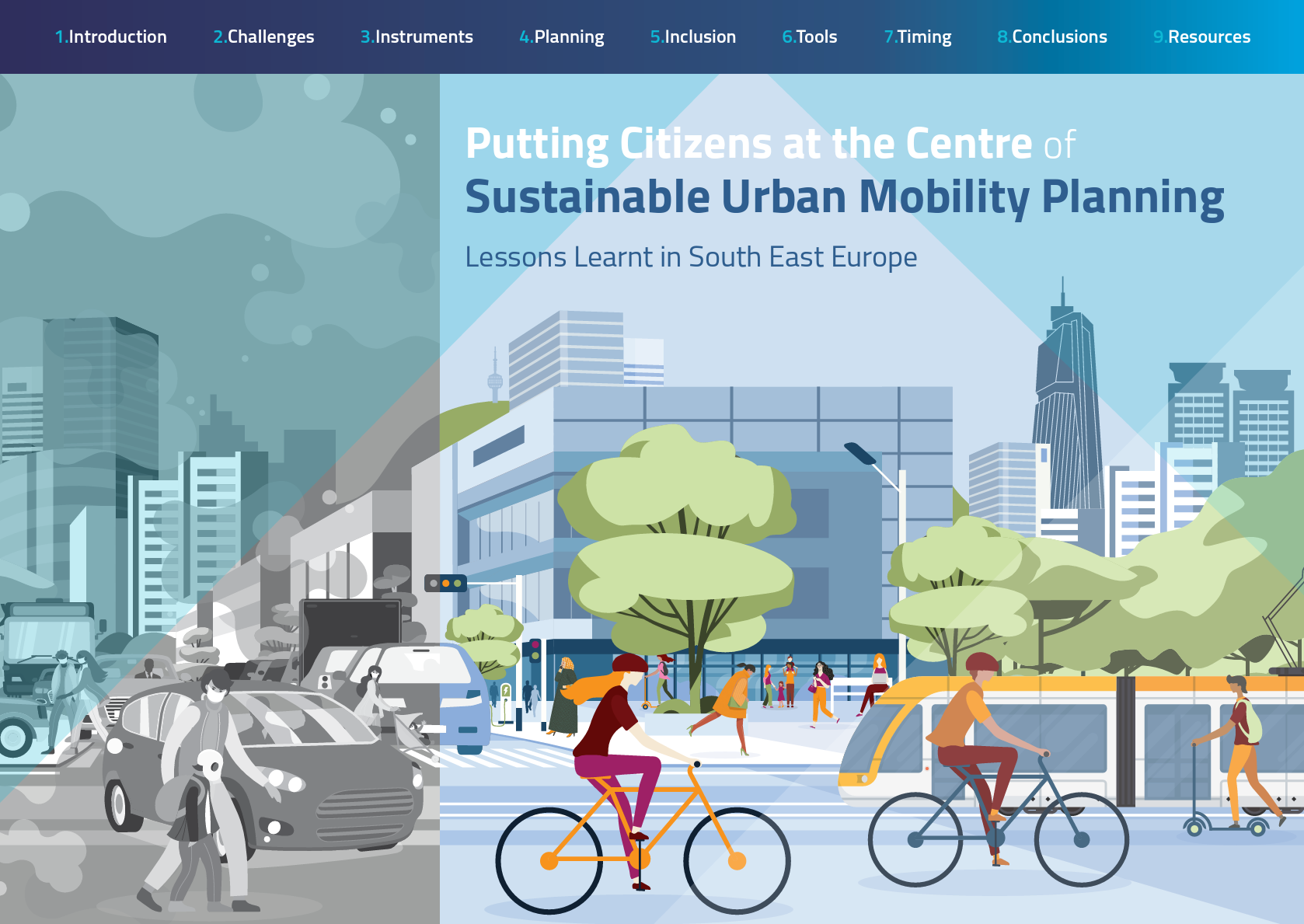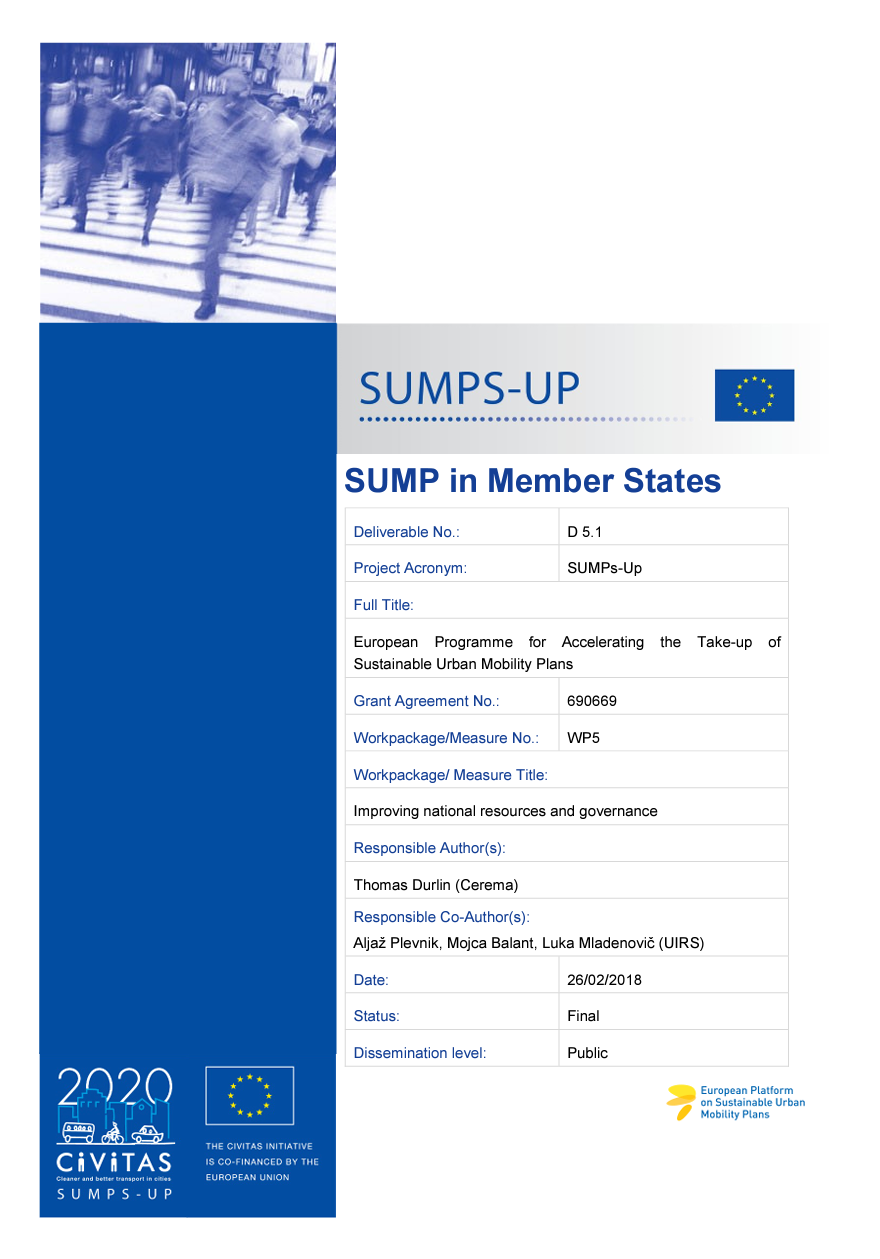
There is very little information available on the internet about the implementation of Urban Mobility Plans and the results achieved. A survey was conducted in 2017 of 328 cities across Europe (SUMP in Member States). When asked about the status of SUMP activities, 44% of the cities stated they had no activities at all, were considering developing their first SUMP or were in the process of developing it. The documents presented below provide some information from cities in Europe and how 60 major global cities rank in meeting their distinct mobility challenges and the varied solutions they are pursuing with or without having developed an Urban Mobility Plan. The city of Dresden has published its initial evaluation of the implementation of the city's Sustainable Urban Mobility Plan and this is available below. Transport Canada has recently published a review of how prepared are eight large Canadian municipalities in planning for, adopting, and advancing urban mobility innovations.
Canadian Urban Mobility 2.0 | Transport Canada | 2022
This report explores the question: How prepared are large Canadian municipalities in planning for, adopting, and advancing urban mobility innovations. To answer this question, Transport Canada performed a municipal policy scan for eight of the country’s largest urban centres, including regulatory documents, policy documents and guidelines, council reports, and budgets. Each municipality was given a SWOT analysis, which provides a broad, easy-to-digest assessment of its specific strengths, weaknesses, opportunities, and threats. It also includes a Mobility Innovation Index which maps how municipalities use transportation projects to support sustainability, innovate with technology, and advance the public good.
Demonstrating economic benefits from sustainable mobility choices – the EVIDENCE project | ELTIS | 2022
The EVIDENCE project (financed by the EU Intelligent Energy Europe programme) sought to demonstrate the economic value of sustainable urban mobility interventions and has produced a large body of evidence to support an enhanced role for sustainable urban mobility in EU cities. It reviewed in detail 351 documents (out of 750 documents identified) which included specific evidence in relation to 22 types of mobility measures. This evidence is presented and summarised in a series of documents that are accessible on the EVIDENCE website.
Dresden’s City Council passed SUMP 2025plus on 20 November 2014. The resolution included a requirement to report to the City Council at three-year intervals on the implementation of the plan. This report contains the results of the first evaluation as of 2017. Work on a quarter of the 90 short term measures has been completed, almost two thirds are still in process, nearly ten percent has not been started yet, and four are currently not being pursued. Of the 57 long term measures, 51 are currently being applied, five have not been started yet, and one has been postponed. In terms of objectives, the SUMP target of increasing the number of residents within the local public transport catchment area has been achieved. Overall, the City of Dresden’s SUMP 2025plus plan has earned recognition at national and international level. It is a reliable basis for action as a strategy for the future of mobility in Dresden. It is also the foundation for other plans, such as the Integrated Urban Development Concept (INSEK). Not least thanks to the broad-based participation of specialists and the public, it has succeeded in proving its legitimacy.
Effective measures in Sustainable urban mobility plans (SUMPs) | Hudoklina, Mladenoviča, Balanta, Ryeb | 2021
This paper presents the results of an analysis of measures implemented in ten European cities that have been effective in reducing the share of trips by car and increasing the shares of active mobility and public transportation. In these cities the share of car use has reduced on average from just under 50% to around 35% in a period of several years.
The aim of this document is to present the Good Practices (GPs) that were collected as part of the activities of the EU REFORM Project. The goal of the REFORM project is to improve, through a mutual learning process, the policies of Regional Operational Programs supporting the funding and diffusion of SUMPs as the main planning instruments for shifting mobility towards a low carbon intensive mobility. The state of SUMPs in the REFORM Project Regions (Central Macedonia in Greece, Emilia-Romagna in Italy, Greater Manchester in the UK and Parkstad Limburg in the Netherlands) is described in this report, as the basis for the identification of Good Practices. A total of 26 Good Practices were identified and the document reports on the actions undertaken in order for them to be identified and described. It provides a review of actions to improve sustainable mobility and promote SUMP implementation and adoption.
This report reflects on experiences with engaging citizens during the development of SUMPs in the capital cities of Sarajevo (Bosnia and Herzegovina) and Tirana (Albania) in 2019/2020. The initial lessons learnt in these cities (as well as other examples from South East Europe) may be a helpful starting point for other cities in the region who are just getting started with their own path towards Sustainable Urban Mobility and public participation.
Rise of a New Sustainable Urban Mobility Planning Paradigm in Local Governance: Does the SUMP Make a Difference? | Radomíra Jordová and Hana Brůhová-Foltýnová | 2021
Using qualitative and quantitative methods of data analysis, this paper aims to explore the institutional settings, practices, and barriers to sustainable mobility in Czech cities and differences between cities with and without a SUMP. The data were collected using interviews and an online questionnaire survey among stakeholders who substantially influence the urban planning praxis. The data reveal that monitoring, evaluation, and public involvement are underestimated by analyzed cities and the perception of a need for a significant transport behavior change is still quite low among local politicians. A SUMP brings substantial benefits to Czech cities of all sizes, even in the initial phase of its implementation. The cities that have developed a SUMP apply various sustainable transport measures more often, create more participation activities, and are better at evaluation than cities without a SUMP.
SUMP in Member States | CIVITAS | 2018
This report provides the status of SUMP development in Europe in 2017. A total of 1,000 SUMPs weren identified in Europe and of these, 328 cities participated in a survey undertaken by the CIVITAS SUMPS-UP team. 37% of these cities had a plan that qualifies as a SUMP. The national SUMP programme analysis pursued the following main research questions:
- What is the current status of SUMP development in Europe?
- What are the drivers to develop a SUMP?
- What are the barriers to develop a SUMP?
- What is the current status of national SUMP programmes and SUMP take-up in Europe?
- Which elements of existing national SUMP programmes work best?
- What do countries need to (further) develop their national SUMP programme.
The report contains 2 Annexes that compile all national inventories and interviews conducted during the data collection phase and 21 best practices for topics concerning national programmes.
Sustainable Urban Mobility in the EU | European Court of Auditors | 2019

The European Court of Auditors examined the extent to which EU support was effective in contributing to improving urban mobility in a sustainable way. In particular, they assessed whether EU cities have made progress towards improving sustainable urban mobility since the 2013 Urban Mobility Package. They concluded that:
- There is no clear trend towards more sustainable modes of transport.
- Overall there has been no significant reduction in private car usage.
- There are still many cities exceeding EU minimum air quality standards.
- Greenhouse gas emissions due to road transport have been steadily increasing.
- Travel by public transport often takes more time than by private car.
They made the following recommendations
- Collect, submit and publish regularly relevant data on urban mobility; and
- EU funding for urban mobility should be conditional on the existence of a SUMP.
Sustainable Urban Mobility Plans in Spain. A Critical Analysis | Márquez‐Ballesteros and Navas‐Carrillo | 2022
This paper evaluates Sustainable Urban Mobility Plans (SUMPs) prepared for sixteen of the most populated cities in Spain. It assesses their effectiveness using four groups of indicators: current relevance and validity, conceptual approach, objectives and targets and awareness‐raising actions.
Urban Mobility Readiness Index 2021 | Oliver Wyman Forum | 2022
The Oliver Wyman Forum, in partnership with the University of California, Berkeley, has produced the 2021 Urban Mobility Readiness Index to show how 60 major cities rank in meeting their distinct mobility challenges and the varied solutions they are pursuing. They tend to be leaders in understanding the importance of mobility and serve as economic epicenters for their regions, making their efforts to improve mobility vital to the growth of much wider areas. The cities also were chosen because data is available to assess, compare, and track the evolution of their mobility capabilities. The 2021 Urban Mobility Readiness Index provides access to richly textured and extensive data on five dimensions that comprise 57 different metrics. It includes four different sets of rankings:
- Overall ranking: ranks all 60 cities on their overall Urban Mobility Readiness score. The ranking rates the city's present readiness as an indication of its future mobility capacity.
- Regional ranking: shows the relative position of all the cities within a given region.
- Dimension rankings: enables the user to drill down into the detail of how the 60 cities performs on each of the five dimensions.
- Sustainable Mobility ranking: new to the 2021 Index, this ranks cities on their journey toward environmentally sustainable mobility. It is a sub-index compiled from 15 existing metrics relevant to sustainable mobility and one new indicator: cycling infrastructure.
Urban mobility strategies during COVID-19 | EIT Urban Mobility | 2021
In order to have a first-hand impression of the impacts from the pandemic in urban environments, a group of 16 cities was surveyed and interviewed by EIT (the European Institute of Innovation & Technology). Some cities have used COVID-19 in their favour to foster the development of mobility plans and/or new measures to transform their mobility system taking advantage of the clear window of opportunity. Cities did not radically change with the pandemic, instead, they adapted and evolved at a higher pace with already existent solutions but not yet deployed at a higher scale. Distinct scenarios can be found in different cities. Such as the ones who barely changed their plans or infrastructures compared to the already existing ones; others due to staff redeployment and budget constraints had to put most of their strategic plans on hold to tackle more urgent health needs created by the pandemic; and others that had the chance to push new mobility projects they had in the pipeline forward as the need for change became even more evident with the pandemic. Cities are trying to face challenges with various strategic approaches: proximity urban planning, seamless inter-modality and public space redesign







